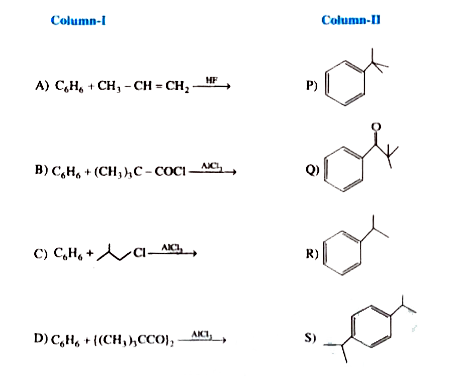The correct stability order of the following resonance structures is
Solution in Telugu
The correct Answer is:C
Stability order
Topper's Solved these Questions
- BOOK - AAKASH SERIESCHAPTER - HYDROCARBONSEXERCISE - ADDITIONAL PRACTICE SHEET ( LEVEL-II (LECTURE SHEET (ADVANCED) (MORE THAN ONE CORRECT ANSWER TYPE QUESTIONS)))20videos
HYDROCARBONS
- BOOK - AAKASH SERIESCHAPTER - HYDROCARBONSEXERCISE - ADDITIONAL PRACTICE SHEET ( LEVEL-II (LECTURE SHEET (ADVANCED) (LINKED COMPREHENSION TYPE QUESTIONS(PASSAGE-I))))3videos
HYDROCARBONS
- BOOK - AAKASH SERIESCHAPTER - HYDROCARBONSEXERCISE - PRACTICE SHEET (EXERCISE - VI (LEVEL-II (MATRIX MATCHING TYPE QUESTIONS )))4videos
HYDROCARBONS
- BOOK - AAKASH SERIESCHAPTER - GENERAL ORGANIC CHEMISTRYEXERCISE - QUESTIONS FOR DESCRIPTIVE ANSWERS35videos
GENERAL ORGANIC CHEMISTRY
- BOOK - AAKASH SERIESCHAPTER - HYDROGEN AND ITS COMPOUNDSEXERCISE - QUESTIONS FOR DESCRIPTIVE ANSWERS20videos
HYDROGEN AND ITS COMPOUNDS
Similar Questions
Which would give isobutane on decarboxylation ?
03:01View SolutionAddition of HX on alkene proceed through formation of carbocation . This reaction is follows Markovnikov's rule. According to markovnikov's rule addition of electrophile occurs on that carbon of alkene which have more number of -H atom
Ph−CH=CH2−−→HXPh−x∣CH−CH3(major)+Ph−CH2−CH2−X(minor)
Which of the following alkenes can produce diastereomers06:31View Solution 07:04View Solution
07:04View SolutionMention the hybridisation stste of each carbon in the following compounds.
CH3−CH=C=O,CH3−C≡C−CH3,CH3COCH3andCH2=CHCNView SolutionWhy the use of hard water is disadvantages?
03:42View SolutionThe correct stability order of the following resonance structrue is : H_2 C = overset (+)(N) = overline(N) H_2 overset (+)C = (N) = overline(N) H_2overline( C) - overset (+) (N) -= N H_2overline( C) - overset (+) (N) -= N .
06:52View SolutionThe correct stability order of the following resonance structures is : x H_(2)C=overset(o+)underset((I))N=overset(Ɵ)N H_(2)overset(o+)Cunderset((II))-N=overset(Ɵ)N H_(2)overset(Ɵ)C-underset((III))overset(o+)N-=N H_(2)overset(Ɵ)C-underset((IV))N=overset(o+)N
04:27View SolutionArrange the following resonating structures in order of increasing stability
CH2=+N=−N(I) H2+C=N=−N(II) H2−C−+N≡N(III) H2−C−N=+N(IV)02:00View SolutionThe correct stability order of the following resonating structure is : underset("(I)")(H_(2)C=overset(+)N=overset(-)N)" "underset("(II)")(H_(2)overset(+)C-N=overset(-)N)" "underset("(III)")(H_(2)overset(-)C-overset(+)N-=N)" "underset("(IV)")(H_(2)overset(-)C-N=overset(+)N)
02:05View SolutionThe correct stability order of the following resonance structures is {:((a) H_(2)C = overset(+)N - N^(-) ," "H(2)overset(+)C-N=N^(-)),( (I), " "(II)),(H_(2) overset(-)C-overset(+)N-=N,H_(2)overset(-)C-N=overset(+)N),((III)," "(IV)):}
07:15View Solutionनीचे दी गयी अनुनाद (resonance) संरचनाओं के स्थायित्व का सही क्रम हैं :
H2C=+N(I)=N− H2+C−N(II)=N−
H2−C−+N(III)≡N H2−C−N(IV)=+N03:42View SolutionThe name of the given structure:
⎡⎢ ⎢⎣−O∣∣C−(CH2)4−O∣∣C−N∣H−(CH2)6−N∣H−⎤⎥ ⎥⎦n is04:54View SolutionThe nitrite ion can be represented, {:(,"I."[:overset(..)underset(..)O-overset(..)N=overset(..)underset(..)O]^(-)),([overset(..)underset(..)O=overset(..)N-overset(..)underset(..)O:]^(-),),(,"II."[overset(..)underset(..)N=overset(..)O-overset(..)underset(..)O:]^(-)):} Which of the structure represents possible resonance forms of this ion?
03:26View SolutionWhich is a resonance form of the Lewis structure shown here?
[:..S..: C::: N]−(P)[:..S..: N::: C]− (Q)[:..S..: C:: N..]−03:26View SolutionWrite the stability order of conjugate structures: (c)overset(o+" ")(CH)_(2) - overset(.)N = underset(Ө)overset(..)N (d) overset(Ө" ")(CH)_(2) - overset(..)N = overset(" "o+)overset(..)N
07:20View Solution

